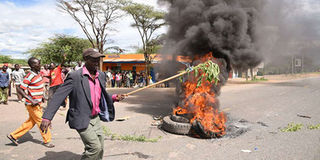Kerio Valley neglect bore ‘Triangle of Hell’

Residents of Saimo Soi Ward in Baringo County on April 23, 2018 protest against mounting cases of cattle rustling. PHOTO | FILE | NATION MEDIA GROUP
What you need to know:
- Media coverage of the raging insecurity in the northern counties tend to mix up issues, with political insinuations masking the spectacular failure by authorities to rein in cattle rustlers.
- A complex trade in weapons and stolen livestock, and deteriorating climatic conditions, have been the key drivers of the armed conflict.
Growing up in Kerio Valley had lasting impressions on me.
The joys of rearing livestock, the daredevil exploits of swimming in the crocodile-infested Kerio River, hunting and cross-border duels with Pokot youths defined our teenage years. It was a happy valley with food in plenty.
But come the early 1990s, gun-fuelled cattle rustling started and, three decades later, its frequency and brutality defies comprehension.
My Kerio Valley has changed — first to the “Valley of Death” and now, within the security sector, the “Triangle of Hell”!
Amid the uproar over the disarmament of National Police Reservists in Kenya’s volatile north, which has left residents at the mercy of deadly cattle rustlers, this new media characterisation of three neighbouring counties — West Pokot, Elgeyo-Marakwet and Baringo — has escaped the attention of many.
The media have given insecurity and disarmament wide coverage.
MEDIA COVERAGE
However, in a story, “State confronts guns nightmare in restive north as locals resist” (DN, May 27), the characterisation — by security sources no less — of the region as the “Triangle of Hell” had me alarmed.
It betrayed an unspoken stance among those responsible for guaranteeing security that the region can as well go up in flames!
Cattle rustling has been a phenomenon among the Pokot, Turkana and Marakwet communities for generations. The weapons of choice were spears, bows and arrows.
But these raiders use guns and other sophisticated weapons, and not only target to steal livestock, but also kill the owners!
Media coverage of the raging insecurity in the northern counties — including Turkana, Samburu and Laikipia — tend to mix up issues, with political insinuations masking the spectacular failure by authorities to rein in cattle rustlers.
RESOURCES
And nothing demonstrates the lack of seriousness by the government in tackling insecurity in the bandit-hit North Rift than reports of police receiving a paltry 450 litres of fuel a month in Baringo North.
The same issue of the Nation carried a photo of an armoured personnel carrier that was grounded in the sub-county for lack of tyres.
And instead of aiding security personnel in patrolling the insecure region, the APC has found some other use — as a chicken coop!
Any strategy to permanently end gun possession among residents must view them not just as perpetrators of armed conflicts but also as victims.
Over the years, sustained attacks from neighbours and the perceived absence of reliable state security has been a key reason why pastoralists have resorted to arming themselves.
DISARMAMENT
A complex trade in weapons and stolen livestock, and deteriorating climatic conditions, have been the key drivers of the armed conflict.
How the government goes about sealing the vast, porous borders will make or break its ambition to enforce state security presence.
The firearms registration and vetting of reservists should be systematic to avoid public anxiety and giving a free pass to rustlers to target residents and their livestock.
Deployment and utilisation of security officers has been ineffective and their impact pales in comparison to the few reservists. That must change.
Mr Cheboi is a resident of Kerio Valley, Elgeyo-Marakwet. @cheboiksam




